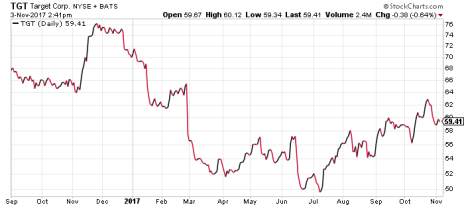Target (TGT) has been a favorite, well, target of Crista Huff, chief analyst of our Cabot Undervalued Stocks Advisor advisory. A year ago, she wrote about one aspect of the big-box retailer’s decline that few mainstream analysts have wanted to touch: its controversial new bathroom policy, and how that policy may have affected TGT stock.
Here’s what Crista wrote, in its entirety, followed by an update on the stock:
Target’s Bathroom Policy
In August 2014, I wrote about Target’s (TGT) costly foray into the Canadian retail scene in “Famed Retailer’s Expansion Blunder Dragging on Stock Price.” Subsequently, in January 2015, Target announced that it would close all of its 133 Canadian stores after determining that profitability would take years longer than originally planned. Target’s presence in Canada was “a mismanaged expansion that racked up billions in losses,” reported Bloomberg.
[text_ad use_post='119904']
It’s actually somewhat unusual for a large American company to make such a poor business decision. That’s why I was incredulous at Target’s bathroom policy. Announced in April, the company said that it would begin to allow transgender customers and employees to use their bathroom of choice.
I immediately knew that Target’s revenue would drop, because its customer base would become disenfranchised. How did Target’s management team not know this? Was there an executive meeting wherein the CEO and the marketing department discussed the pros and cons of this pending decision? Or did the decision solidify during a Kum ba yah moment between martinis at an executive retreat?
We all know the “pros” of Target’s bathroom policy: people want an ideal world where everybody is safe and feels good about themselves. But lots of us foresaw the “cons”: a large portion of Target’s customer base wouldn’t feel comfortable with the controversial decision.
And that’s exactly what’s happened—customer have reacted by boycotting Target.
This wasn’t a tiny boycott. It was national in scope, with 1.4 million people signing a pledge to boycott the stores.
I live in Colorado, where transgender people being able to choose what bathroom they identify with became law in May 2008. That was the day I realized that I could no longer send my daughters into public restrooms alone. So I understood the public’s outrage over Target’s bathroom policy. However, Target’s subsequent quarterly sales weakness took investors by surprise, because Wall Street didn’t cover the boycott in their research reports. Even today, in the three analyst reports on Target that I reviewed from three major research sources, there was not a word about the boycott.
Again, Kum ba yah.
When Research Reports Avoid Uncomfortable Truths
A stock analyst’s job is to report what’s happening with a company, and make estimates as to how it will affect a company’s bottom line and its share price. But if Wall Street analysts won’t do it, I will. Because when research reports dodge uncomfortable truths, investors can’t make well-informed buy and sell decisions.
The boycott has been in place since April, and Target got burned.
For the second consecutive quarter, sales were down. “In the second quarter, our No. 1 challenge was traffic, which affected sales in all of our merchandise categories,” said Target CEO Brian Cornell.
Total in-store customer traffic, which fell 2.2% in the second quarter, hasn’t been this low since the company’s data breach in the fall of 2013—yet another infamous corporate fail.
Target’s same-store sales fell 1.1% in the second quarter, while Wal-Mart’s (WMT) comps rose 1.6%. What’s more, Target forecasts a continued drop in sales comps during the remainder of fiscal 2017 (January year-end).
Did Wal-Mart’s sales surge because their low prices enticed customers away from Target, as widely reported this month, or did Wal-Mart’s sales increase because of Target’s bathroom policy? If you take 1.4 million people’s consumer dollars away from Target, and direct most of those dollars toward their obvious rival, Wal-Mart, then yes, Wal-Mart is going to have an upside surprise in quarterly sales while Target’s numbers disappoint.
But the news gets worse. Target execs had a long-term goal of 3% growth in comparable store sales, a goal that’s looking like a pipe dream. As the company makes downward revisions on its sales goals, that can only hurt the stock price further.
In an attempt to woo those customers back, Target offered a 10% discount on everything in its stores and online on Sunday, August 28. The one-day sale event was called #TargetRunDay.
Good luck with that.
As a mom, and as a woman who has encountered armed criminals in public places, my family’s safety considerations rank higher than feel-good corporate policies. My mantra is, “First, do no harm.” And anybody who knows me knows that I’m vigilant against people and organizations that aim to harm my fellow citizens.
Bottom line: If a retailer makes a decision that increases danger to my family, I’m going to shop somewhere else.
The Outlook for TGT Stock
Currently, consensus estimates show Target’s earnings per share (EPS) growing 6.4% and 8.2% in fiscal 2017 and 2018. Earnings are growing, and that’s good; but the EPS estimates have been frequently revised downward in recent months, and that’s bad for the share price. The current price/earnings ratio (P/E) is 14.1, which is a little high compared to the earnings growth rate and the 3.4% dividend yield.
How low could the share price fall? I’m going to lay out a scenario based upon the dividend yield. When stocks of profitable companies with attractive dividend yields fall out of favor, it’s relatively common that the share price can fall until the dividend yield hovers at about 5%. At that point, the number of buyers who want the high yield tend to offset the number of discouraged shareholders who are selling the stock, and the share price stabilizes.
The annual dividend on TGT is $2.40, so the yield will be 5% if the share price falls to 48. That’s your approximate worst-case scenario.
Turning to the price chart, TGT stock rose to a 2016 high of 84 in April, only to rapidly fall to its 2016 support level around 66 within weeks of the bathroom policy announcement. The share price has been trading between 70 and 76 since early July.

I’m not anticipating an extreme drop in the share price, but I’m definitely not seeing any catalyst on the horizon for the share price to surpass its current trading range. My recommendation is that shareholders sell TGT stock and reinvest their capital into stock of a company with strong earnings growth, low P/E, low debt levels and a bullish chart. I routinely feature such value and growth stocks in Cabot Undervalued Stocks Advisor. Join me for better stock investing ideas!
For details, click here.
TGT Stock Today
More than a year later, we thought it might be interesting to take measure of how TGT stock is doing now. Here’s a chart of what’s happened to it since Crista’s original September 1, 2016 article.
Things started well—especially after the election. But December 2016 all the way through the summer of 2017, TGT stock spiraled downward. And despite a recent upturn, the stock still trades well below where it was when Crista recommended selling it a little over a year ago.
To be fair, TGT did initially break above that 70-to-76 trading range she mentioned, but it plateaued at 78, sank back to the low 70s, and took a sharp downturn once the calendar flipped to 2017. The stock hasn’t traded higher than 63 since February.
So, though it took a while to materialize, if you followed Crista’s advice to sell TGT stock late last year, it’s looking like a good decision now. TGT stock is headed in the wrong direction, and may still have greater depths to plumb.
Good call by Crista!
[author_ad]

